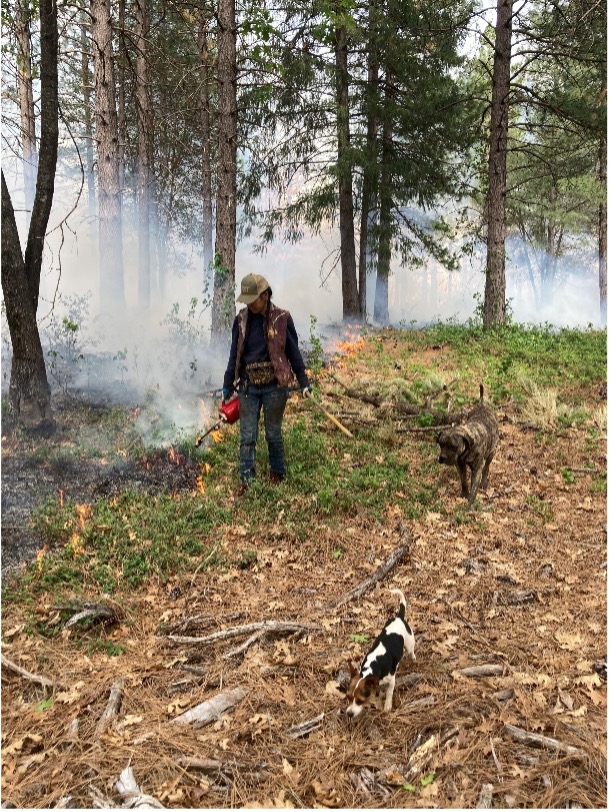
What is prescribed fire?
Prescribed fire is the controlled and intentional application of low-intensity fire across the landscape under specific weather conditions to achieve a management objective.
The term prescribed fire includes both pile burning and broadcast burning. Pile burning is a fuels management tactic where vegetative debris is gathered, piled, and burned in place to remove excess fuels from the landscape. Broadcast burning is where low-intensity fire is applied across a predetermined area (also called a burn unit). It can vary in size from less than an acre to tens of thousands of acres. Pile burning is a great way to prepare a unit for eventual broadcast burning, particularly in forested environments.


Why do we need more prescribed fire?
Most of California is a fire-dependent ecosystem. This means that the native plants and animals have co-evolved and adapted to the application of low-intensity fire. Prior to colonization and the California Gold Rush, indigenous peoples masterfully used low-intensity fire to craft the open and biodiverse forests of the western United States. Fire was applied at regular intervals, ranging from 1 – 7 years, to promote or discourage the growth of certain plants. These plants were used for shelter, tools, medicine, and food. Fire was used for fuels reduction, spiritual traditions, to promote forage for wild game, and many other reasons that kept the landscape and the people productive, healthy, and sustainable.
The California genocide, beginning in the 19th century, eliminated the necessary human interactive management that plants and animals came to rely on. In addition, following The Great Fires of 1910, the United States Forest Service instituted policies of total fire suppression and states like California followed with similar policies, culturally leading us on the path of villainizing fire.
What happens when you remove fire from a fire-dependent ecosystem? In just two short centuries, the overwhelming fuel loads created ideal conditions for catastrophic wildfires such as the Tubbs Fire (2017), Dixie Fire (2021), and Caldor Fire (2021), among many others. The Park Fire in Butte County is currently ripping through communities north of Chico. The lack of fire initiates a cascade of negative ecologic and, hence, economic impacts. Biodiversity plummets, tree mortality increases, and habitat for native insects and wildlife decreases. The economic repercussions equate to billions of dollars in capital losses, health costs, and indirect losses from wildfire damages.
At a broad level, re-introducing prescribed fire is required to improve the health of our watersheds, and therefore our people and our economy. At an individual and community level, prescribed fire will reduce invasive weeds, maintain or improve your defensible space, create safer ingress and egress routes for first responders, increase the quantity of water to our watersheds, and improve the marketability of your home – just to name a few.
Who can use prescribed fire as a tool?
Particularly at low-complexity scales, prescribed fire is a tool that most folks are capable of using! Prescribed fire comes in different forms of complexity. The complexity varies across different factors such as topography, fuel type, seasonality, and size. It also varies according to the skills of the individual, referred to as fire practitioner, and methods of ignition. For example, on the west slope of the Sierra Nevada, a low-complexity unit may look like the images below. Fairly small (1 to 10 acres), surrounded by roads or containment lines at least 4 feet in width, ladder fuels have been removed during prep work. The unit is fairly flat or facing just one aspect. Fuel type is contiguous. The unit is lit using backing fire (an ignition tactic where fire backs against wind and/or slope), moving about 1 foot per minute and flame lengths are less than 2 feet in height. These are just a few examples of low-complexity prescribed fire.




Many landowners feel they have an obligation to maintain their properties. We want to encourage their use of prescribed fire under the appropriate conditions. Once learned, prescribed fire is a cost-effective, labor-efficient method of maintaining low fuel loading, while also getting all the good stuff like native insects and great wildflowers!
As a curious landowner or community member, what resources are available to learn more?
Join Placer Prescribed Burn Association (Placer PBA), or your local prescribed burn association, and attend a workshop and training burn! Placer PBA hosts educational workshops that guide community members through the process of planning, prepping, and implementing a low-complexity prescribed burn on their property. Come volunteer on a prescribed burn with us! The best way to learn is by doing (enjoy helping somebody else burn their property first – all the fun without the responsibility… 😉). We also offer technical assistance site visits, guidance through the permitting processes, help understanding and creating a burn prescription, and on-the-ground training opportunities. If necessary and available, we can support with additional equipment, volunteers, and technical support on the day of implementation.
In the meantime, check out the Rx Fire Field Guide, an introductory guidebook developed by Placer RCD and CAL FIRE, to learn more about the basics of low-complexity prescribed fire.
To join Placer PBA or ask additional questions, contact Cordi Craig, Prescribed Fire Program Manager, at cordi@placerrcd.org. We look forward to hearing from you!
